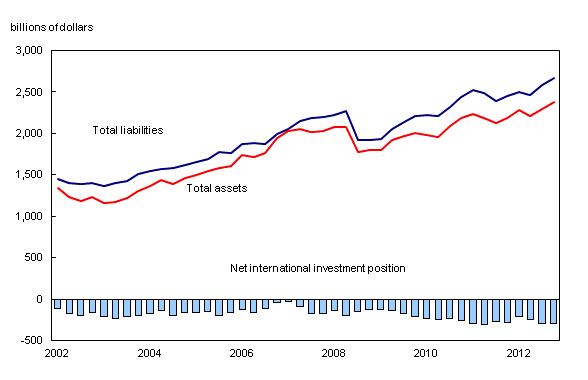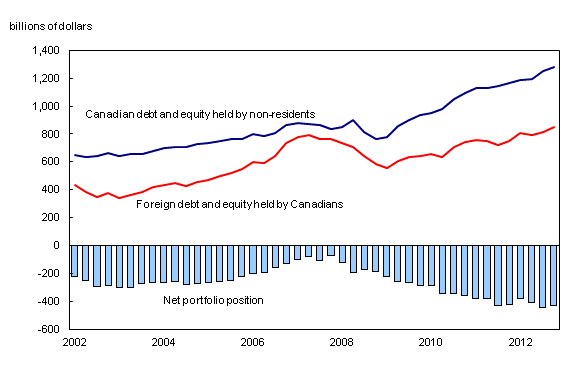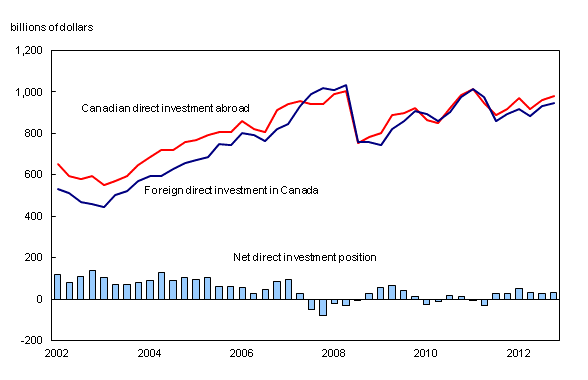Canada's international investment position, fourth quarter 2012
Archived Content
Information identified as archived is provided for reference, research or recordkeeping purposes. It is not subject to the Government of Canada Web Standards and has not been altered or updated since it was archived. Please "contact us" to request a format other than those available.
Released: 2013-03-14
Canada's net foreign debt decreased $4.8 billion to $288.6 billion at the end of the fourth quarter. This reduction mainly reflected the revaluation effect of a weaker Canadian dollar on international assets and liabilities as well as lower inflows of funds from abroad during the quarter.
Net foreign debt has generally trended upward since the second quarter of 2007, at the outset of global credit concerns. Growth in international liabilities over most of this period has been led by non-resident investment in Canadian debt securities. Net foreign debt stands $11.7 billion higher than at the end of 2011, but remains below its post-recession peak of $300.3 billion.
Increased portfolio investment abroad and a weaker Canadian dollar increase international assets
Canada's international assets rose $79.4 billion to $2,375.0 billion by the end of the fourth quarter. Canadian investment activity abroad of $44.7 billion accounted for much of the increase, led by acquisitions of foreign securities. The $28.6 billion gain in the value of foreign currency denominated international assets was also a contributing factor, one that reflected the depreciation of the Canadian dollar against most major currencies. The Canadian dollar declined 1.2% against the US dollar, 3.7% against the Euro and 1.9% against the British pound, but gained 9.8% against the Japanese yen over the quarter.
International liabilities up on continued investment from abroad
Canada's international liabilities rose by $74.6 billion to $2,663.5 billion, largely on sustained investment from abroad. Non-residents invested $59.4 billion in the Canadian economy during the quarter, led by a $26.5 billion increase in deposits held at Canadian financial institutions. In addition, non-resident investors continued to increase their holdings of Canadian bonds and money market instruments by $22.4 billion, while foreign direct investment in Canada accounted for another $14.9 billion of inflows.
Net liability position on securities narrows
Canada's net liability position on securities declined $12.6 billion to $428.3 billion in the fourth quarter. Canadian acquisitions of foreign securities exceeded foreign investment in Canadian securities for the second time in more than four years at the same time as most of foreign stock markets outpaced those in Canada in the quarter.
As a result, Canadian holdings of foreign securities increased $38.4 billion to $850.0 billion at the end of the quarter. Foreign equity assets rose by $23.4 billion, mainly on capital gains and the upward revaluation effect of a depreciated Canadian dollar. Canadian holdings of foreign bonds were up $15.6 billion on strong outward investment flows.
On the other side of the ledger, non-resident holdings of Canadian securities were up $25.8 billion in the fourth quarter to $1,278.3 billion. Canadian debt instruments accounted for all of the increase, largely federal and corporate securities. Foreign holdings of Canadian equities edged down in the quarter, partly reflecting merger and acquisition activity that resulted in non-resident portfolio investors rendering some of their Canadian shares to foreign direct investors.
Canada's net asset position on direct investment edges up
Canada's net asset position on direct investment was up by $4.0 billion at the end of the fourth quarter to $32.1 billion. This followed two consecutive quarterly declines.
Canadian direct investment abroad assets expanded $20.9 billion to $980.0 billion. This reflected strong direct investment outflows and the upward revaluation effect of a weaker Canadian dollar on the value of investments abroad. On the liability side, foreign direct investment in Canada increased by $16.9 billion to $947.9 billion. This was led by higher direct investment inflows, the largest since the first quarter of 2012.
Note to readers
The main measure of the international investment position (IIP) accounts now incorporates market valuation for tradeable securities and foreign direct investment equity. This presentation adds a further dimension to the analysis of Canada's net international investment position and more accurately reflects changes in that position. The IIP at book value is still available, as the link to the annual foreign direct investment release includes geographical and industry details. For more information please see Valuation of assets and liabilities .
Definition
The international investment position presents the value and composition of Canada's assets and liabilities to the rest of the world. Canada's net international investment position is the difference between these foreign assets and liabilities. The excess of international liabilities over assets can be referred to as Canada's net foreign debt; the excess of international assets over liabilities can be referred to as Canada's net foreign assets.
Currency valuation
The value of assets and liabilities denominated in foreign currency are converted to Canadian dollars at the end of each period for which a balance sheet is calculated. Most of Canada's foreign assets are denominated in foreign currencies while less than half of Canada's international liabilities are in foreign currencies. When the Canadian dollar is appreciating in value, the restatement of the value of these assets and liabilities in Canadian dollars lowers the recorded value. The opposite is true when the Canadian dollar is depreciating.
Contact information
For more information, or to enquire about the concepts, methods or data quality of this release, contact us (toll-free 1-800-263-1136; infostats@statcan.gc.ca) or Media Relations (613-951-4636; statcan.mediahotline-ligneinfomedias.statcan@canada.ca).
- Date modified:




